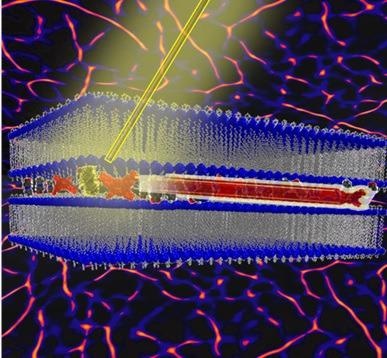A molecular machine can be defined as a series of molecules that can conduct different mechanical movements as a reaction to a stimulus. This is an important structure for the development of various cellular functions.
 An image showing the light excited by a molecular switch (yellow shape between the blue molecular layers that are the path) and the motion of the red molecule along the path. The background is a colored image obtained with the optical microscope used to observe the movement. (Image Credit: University of Barcelona).
An image showing the light excited by a molecular switch (yellow shape between the blue molecular layers that are the path) and the motion of the red molecule along the path. The background is a colored image obtained with the optical microscope used to observe the movement. (Image Credit: University of Barcelona).
Professor Lluïsa Pérez-García, from the Faculty of Pharmacy and Food Sciences of the University of Barcelona (UB), participated in an international study directed by the University of Nottingham, which has developed a light-controlled artificial molecular machine.
This study has been published in the journal Nature Chemistry and is a primary step for the creation of a new category of these molecular structures with probable applications both in the domains of nanomedicine and energy.
Imitating Cellular Molecular Motors
A crucial part of the workings of the cells in living organisms is that molecular motors (a type of molecular machine) move through molecular-specific paths. The new system shows, for the first time, a movement of the kind which occurs along the fibers of the cells.
According to the researchers, the outcomes of the study would be the example of an artificial molecular machine that is perhaps “more similar to cellular molecular motors.”
In this study, we showed that a synthetic self-made molecular fibre in a liquid behaves like a path for the movement of a molecular traveller over a distance 10,000 times its length. The light acts as fuel to favour movement, while a molecular switch mixed into the system propels the traveller into its way.
Lluïsa Pérez-García, Researcher and Professor, Faculty of Pharmacy and Food Sciences, Institute of Nanoscience and Nanotechnology, UB
The scientists employed interactions between oppositely charged chemical groups to produce movement in this static system: a self-assembled cationic molecule forming fibers (the path), to which a fluorescent anionic molecule is incorporated (the traveler).
The third element is an anionic molecule that acts as a molecular switch which, when it irradiates with blue-purple light, diminishes the interaction of the traveler molecules with the path as well as boosts the movement of these across the path.
The molecular switches discharge the heat when irradiated, an effect that stimulates the molecular traveler to travel, so that the mechanical movement of the switch, and the discharged heat, are key for the system to function.
To perceive these effects, the scientists used a unique optical microscope that allowed concurrent stimulation of the molecules — causing them to move — and observation of them when they irradiated, as the traveler molecules were fluorescent.
Transporting Charged Molecules from One Place to Another
The next challenge for the scientists is to make other molecules travel from one place to another in a regulated manner and to imitate nature so that these can transport a charge, but using light as a source of energy.
This system could be used to conduct chemical tasks, perhaps in miniaturized devices to detect chemical products, and in the application of light-activated drugs.
Lluïsa Pérez-García, Researcher and Professor, Faculty of Pharmacy and Food Sciences, Institute of Nanoscience and Nanotechnology, UB
Another possible application is to discover new approaches to using light energy.
Since we work moving travellers from one place to another, if we take the energy this new system produces, it would be a simple way of getting energy.
Lluïsa Pérez-García, Researcher and Professor, Faculty of Pharmacy and Food Sciences, Institute of Nanoscience and Nanotechnology, UB
Journal Reference:
Samperi, M., et al. (2021) Light-controlled micron-scale molecular motion. Nature Chemistry. doi.org/10.1038/s41557-021-00791-2.